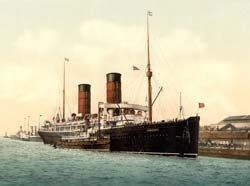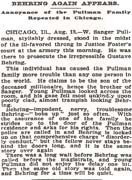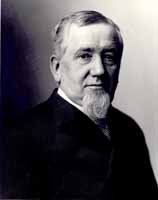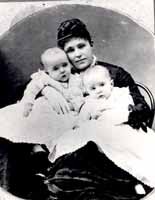Gustave Behring
You are at Home -> George Mortimer Pullman -> Gustave BehringThe Strange Case of Gustave Behring
Did George M. Pullman have an illegitimate son? Throughout the 1890s, a man named Gustave Behring pressed his claim that he was Pullman's love child. According to the Cedar Rapids Evening Gazette, December 14, 1897, Gustave Behring, 28, was a sergeant in the German Army when he was called to his dying mother's bedside. On her deathbed, she confided in him that his real father was none other than George M. Pullman. She showed him the letters that Pullman had sent her, promising “to care for her child” and commanded her to son to convey to his father that she still loved him as in her youth and wished to reaffirm her vows to him. According to her story, she and Pullman became “acquainted” while Ms. Behring was a governess in Chicago for a house on the west side. They were intimate for over a year, according to her love letters, and Pullman promised to marry her many times over the course of the affair. When she became pregnant, Pullman allegedly packed her off to her native Germany , supplied her with $500, and told her to lay low for a while. She never heard from him again. Behring later claimed that Pullman had actually married his mother in 1867, living in Chicago under the assumed name of Schmidt. Behring promptly resigned his commission in the Guard to pursue this mission. He arrived in Chicago , expecting a warm paternal welcome; however, this was not to be the case. He went to the Pullman building downtown, making it past the guards and Pullman 's secretary, and met with Pullman briefly. Pullman threw him out of his office and had security oust him: “they [the guards] soiled their sleek hands on Behring's garments and pushed him out onto the street.” Behring did not give up. He tried to push his way back in. The guards subdued him and called the police. He was then confined in a mental institution, “regarded in the county court as suffering from a severe form of dementia.” He found a sympathetic doctor at the asylum, originally from Germany , who released him on parole after a few days detention. Behring apparently took to lurking outside of the Pullman Building after his first brush with the law, getting arrested 6 times more. Four days before Pullman's death (putting it at October 15, 1897), Behring finally managed to confront Pullman on his way into his office. The conversation was actually recorded: BEHRING: You are my father!PULLMAN: You are a crazy man!
BEHRING: Mother told me to come all the way from Germany and tell you of her death.
PULLMAN: I do not know you or your mother and don't bother me!
Pullman died on October 19th. Less than 12 hours after the funeral, Behring showed up at the family's residence on Prairie Avenue, demanding to speak to Mrs. Harriett Pullman (George's widow). Apparently, he was met on the steps by Pullman's sons and the family lawyers, all of whom were nonplussed as to what to do with this man. He was eventually arrested again. On October 29th, according to the Los Angeles Times, Gustave Behring was “examined by an insanity expert today, who pronounced the man sane. He was accordingly discharged from custody. Behring declares that he will push his claim against the estate of the dead millionaire.” Behring faced another sanity hearing, presumably after yet another arrest, on April 21, 1898. According to the Chicago Tribune of April 22nd, he was again declared sane in the court of Judge Jones. On August 14, 1898, the New York Times reported that Walter Pullman (Pullman's son) was in court prosecuting Behring before Justice Foster. Pullman secured a restraining order against Behring. The New York Times of September 18, 1898 reports him being escorted to the Cunard liner Campania by detectives, bound for Bremen.
 New York Times, September 18, 1897 |
 The S. S. Campania |
THE PULLMAN HISTORY SITE

George M. Pullman and his Family
The Twins
Images of Pullman and Family
Other Pullman-Related Sites
- Historic Pullman Garden Club - An all-volunteer group that are the current stewards of many of the public green spaces in Pullman. (http://www.hpgc.org/
- Historic Pullman Foundation - The HPF is a non-profit organization whose mission is to "facilitate the preservation and restoration of original structures within the Town of Pullman and to promote public awareness of the significance of Pullman as one of the nation's first planned industrial communities, now a designated City of Chicago, State of Illinois and National landmark district." (http://www.pullmanil.org/)
- The National A. Philip Randolph Pullman Porter Museum is a 501(c)3 cultural institution. Its purpose is to honor, preserving present and interpreting the legacy of A. Philip Randolph, Pullman Porters, the Brotherhood of Sleeping Car Porters and the contributions made by African-Americans to America's labor movement. ((http://www.nationalpullmanportermuseum.com/)
- Pullman Civic Organization - The PCO is a strong and vibrant Community Organization that has been in existence since 1960. (http://www.pullmancivic.org/)
- Pullman National Monument - The official page of the Pullman National Park. (https://www.nps.gov/pull/)
- South Suburban Genealogical & Historical Society - SSG&HS holds the Pullman Collection, consisting of personnel records from Pullman Car Works circa 1900-1949. There are approximately 200,000 individuals represented in the collection. (https://ssghs.org/)
- The Industrial Heritage Archives of Chicago's Calumet Region is an online museum of images that commemorates and celebrates the historic industries and workers of the region, made possible by a Library Services and Technology Act grant administered by the Illinois State Library. (http://www.pullman-museum.org/ihaccr/)
- Illinois Digital Archives (IDA) is a repository for the digital collections libraries and cultural institutions in the State of Illinois and the hosting service for the online images on this site. (http://www.idaillinois.org/)





